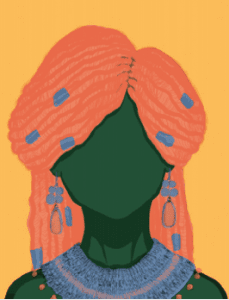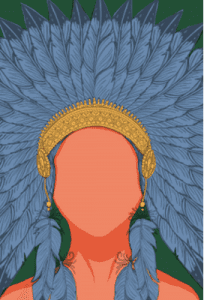You’re likely to have heard of the term cultural appropriation, and if you haven’t – it’s more likely you’ve seen examples of it.
Consider social media posts you’ve seen of people dressing for Halloween as Native Americans in feathers and headdresses, or Mexican costumes in ponchos, or as geishas dressed in kimonos.
Celebrities and artists are constantly under the radar for cultural appropriation. Remember the uproar sparked from Kim Kardashian’s “boxer braids” hairstyle? Or Katy Perry dressed in a kimono for her live performance of Unconditionally? Even the queen bee herself (aka Beyoncé) has been scrutinised amid the cultural appropriation debate, in her music video with Coldplay dressed as a Bollywood star.

Credit: Design by Rachana Udaya Kumar
Whether these examples are in fact cultural appropriation or not, can be ambiguous and assessed on a case-by-case basis. This contentious term can be seen as conceptually unstable, as there can be vague guidelines as to what constitutes it.
Oxford Living dictionaries deem cultural appropriation as the “unacknowledged or inappropriate adoption of the customs, practices, ideas … of one people or society by members of another and typically more dominant people or society”.
In the most digestible way possible, appropriation occurs when a privileged culture borrows from a marginalised culture. Taking elements from a culture can divorce them from their original meaning or be used as entertainment without considering its original value, meaning or context.

Credit: Design by Rachana Udaya Kumar
Think of cultural appropriation as something similar to plagiarising in your university essay. By plagiarising, you’re not crediting the person who created the idea, concept or piece of information you’re using, and possibly even taking the credit for writing it yourself. Perhaps you even distorted the idea or message the original writer intended?
As described by Danielle Bainbridge in the Origin of Everything, this can be damaging to the marginalised culture. She explains that the privileged culture may not have to deal with the same ramifications that someone from their culture would have to deal with as a result of those same actions.
For instance, when we consider Kim Kardashian’s boxer braids, this has been arguably deemed cultural appropriation as the hairstyle was presented as merely stylish or fashionable. However, braids for African women not only have deep historical roots attached to it, but they are also deemed necessary and functional ways to keep their hair neat.
As Lori Harps, co-author of Hair Story: Untangling the Roots of Black Hair in America states to the Washington Post, black hair has a long history of being politicised and stigmatised in the workplace – for men as well as women.
To put it further into perspective, Kenyan James Emmanuel discusses his experiences with his hair to the Huffington Post. When he was in grade 10 and came back to his NSW school from visiting family in Kenya, he was told his twist-braid hairstyle was “unacceptable” and “extreme”.
“School years were spent being coerced into shaving my head – expelling signs of Afro-textured hair – to meet white standards of presentability,” says James. Similarly, he discusses how black women are expected to assimilate and “damage” their hair with chemicals by straightening their natural curls.

Credit: Design by Rachana Udaya Kumar
“Punishing the origin forces them to stop or reduce their use of the culture, and theirs is soon replaced by an appropriated version,” James adds.
In a viral video, actress Amandla Stenberg adds to the discussion of cultural appropriation by considering the complex cultural context of cornrows.
“Appropriation occurs when a style leads to racist generalisations or stereotypes where it originated, but is deemed high fashion, cool or funny when the privileged take it for themselves,” Amandla says.
When we think about Halloween examples, such as people dressing in Native American costumes, a quick Google search will show you an array of websites selling “sexy Indian” costumes. This can be trivialising and dehumanising to Native Americans, as their cultural identity is being used as costumes or accessories, overly sexualised, and being used for profit.
These kinds of cultural costumes are mainly watered-down and inaccurate versions of their original garments, taking away from and misrepresenting its historical value, significance and meaning.

Credit: Design by Rachana Udaya Kumar
In our globalised and Western world, we have increased access and exposure to different cultures. Cultural influences are often commonplace, from our room décor, to the clothes we wear, the music we listen to, and food and drinks we consume. So, where do we draw the line?
That’s where cultural appreciation comes to play. In this context, when participating in other cultures, appreciation can be achieved by:
- Taking the time to learn and appreciate the culture, and the significance behind what you are participating in.
- Using cultural elements as intended to avoid belittling its cultural significance.
- Avoiding participation just because it’s trendy, fashionable or stylish.
- Giving credit or recognition to items or practises associated with a culture, rather than claiming them to be your own.
- Purchasing items from small businesses run by original members of a culture, rather than mass-produced items.
- Consider whether you are reinforcing stereotypes or racism.



